During these unprecedented times, it’s crucial that we stay home and work safely, but more importantly, that we keep our lungs and immune systems healthy to improve our body’s ability to fight off infections. As you know, COVID-19 obstructs respiratory pathways with thick mucus. For medicines and treatments to work, the airways must be open and unblocked. To actively fight off any viral infections, you need to maintain healthy lungs.
We absolutely must take the proactive route to improving our resistance and lung health. Determining the health of our lungs comprises two parameters – Lung Capacity (the extent to which our lungs can fully expand); and Lung Function (the efficiency with which lungs process oxygen and distribute it to the rest of the body). We are all born with Lung Capacity, but Lung Function is another story. Our lungs grow from birth until about age twenty-five. Then growth plateaus for a decade, post which an aging process sets in, where we lose function gradually, over time. Sedentary lifestyles worsen lung function, since it results in a loss of muscle tone and endurance – both of which can be reflected by a drop in breathing capacity.
Activities like strength training and cardiovascular exercise help get the most out of lungs and increase how efficiently they use oxygen. Aerobic activity is good for eliminating carbon dioxide, and strength training helps thoracic cage muscles and core strength, which are very important in breathing. Both activities strengthen the diaphragm and help improve posture. If someone were to get a severe bout of COVID-19, having that strength in reserve can prove lifesaving!
Increasing your airflow with physical activity improves the flow of oxygen in your bloodstream, which then increases airflow to your muscles, heart and lungs. 30 minutes of moderate exercise, 5 times a week, is recommended to benefit lung health. Not everyone should start an unmonitored exercise program, it must be done under the supervision of a competent physiotherapist. For the elderly, or for those with physical limitations, deep breathing exercises do wonders. Take three breaths, as big and deep as you can, every hour on the hour. This can help mobilize parts of the lung that are sitting there unused. If parts of your lungs are quiescent, then you’re really setting the stage for secretions to sit there and fester, giving you the perfect environment for pneumonia.
Always maintain good posture. Since the lungs are soft structures, they only take up room that you make for them. You want to occasionally sit tall and reach overhead, to make more room for your lungs. A simple technique for giving your lungs even more room is leaning back slightly in a stable chair, lifting the chest and opening the front of your body as you breathe deeply.
Although there’s much to learn about COVID-19, we know that those with underlying conditions like diabetes and obesity seem to fare worse. Researchers suspect this could be due to chronic inflammation, which is thought to influence how the body releases inflammatory substances called cytokines. While short-term inflammation can actually help heal the body (think swelling that appears after a minor injury and then quickly disappears), chronic inflammation throughout the body can trigger a severe, over reactive immune response called a ‘cytokine storm’ when confronted with a pathogen. Cytokine storms cause organ damage and even kill people with influenza. Researchers believe they are responsible for severe lung damage and death in COVID-19 patients.
Reducing chronic inflammation before sickness strikes can help prevent the risk of a cytokine storm. The best way to do that is nutrition – intake of foods high in antioxidants like fresh fruits and vegetables – pomegranates, beetroots, beetroot greens, tomatoes, onions, turmeric, ginger and garlic are super foods that help maintain good lung health. Avoid the MRP diet i.e., Milk and Meat products, Refined products and Processed food. Make sure you get plenty of sunshine and maintain sufficient vitamin D reserves. Building up your immune system and reducing inflammation are crucial during viral infections.
Hydration is key to keeping your lungs lubricated, so that irritants and mucus thins out. Ensure you’re taking your daily water quota, especially as it’s summer now, making it more important to keep sipping water through the day. The more irritated your lungs are by external sources, the more inflamed they get. Hence, reduce your exposure to aerosols and sprays like cleaners and body sprays, pollens and dust. Smoking should be avoided at all costs – it causes lung cancer and passive smoking too causes lung inflammation. Tobacco and even vape smoke includes dozens of chemicals and carbon monoxide displacing healthy oxygen in your lungs.
To best protect your lungs, it is also crucial to protect your teeth, gums, and tongue. Brush and floss twice per day to prevent the buildup of plaque and potential infections in your mouth which migrate from your mouth into your lungs, compromising their ability to function properly. If you have a sore or scratchy throat, it’s important to soothe it so that throat irritation doesn’t migrate to the lungs. Drink warm liquids like water with a squeeze of lemon. Warm liquids soothe the throat and increase hydration and the flow of gastric juices in the stomach, helping reduce inflammation. Gargle with warm salt water every few hours as it prevents throat infections.
Steam Inhalation should also be done every few hours. The mistake that many of us do with steam inhalation is we add some oils or liniments such as eucalyptus oil or ‘Vicks Balm’, I would strongly discourage this practice. Just good old steam inhalation works its magic.
To conclude, I wish for us all to love more and laugh even more. Laughing is a great exercise to work the abdominal muscles and increase lung capacity, it also clears out your lungs by forcing out stale air and allowing fresh air to enter into more areas of the lung.
The following are a few simple breathing exercises to be followed to reduce the chances of lung complications. All exercises have to be repeated 8 to 10 times and practiced thrice a day:
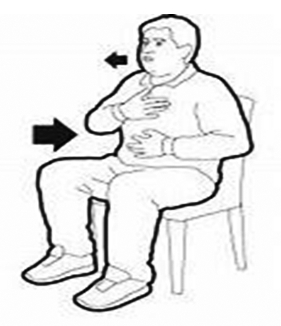 (I) Deep Breathing Exercise: Sit on chair or lay on the bed. Place your both hand over the chest. Take a deep breath through your nose (chest rises up). Hold it in for 4 to 5 seconds. Now exhale through your mouth slowly.
(I) Deep Breathing Exercise: Sit on chair or lay on the bed. Place your both hand over the chest. Take a deep breath through your nose (chest rises up). Hold it in for 4 to 5 seconds. Now exhale through your mouth slowly.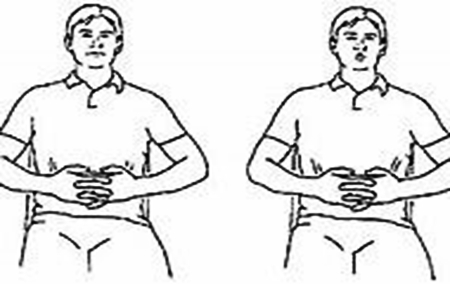
(II) Diaphragmatic Breathing Exercise: Sit on chair or lay on bed. Place your both hand over abdomen. Take a deep breath through your nose (abdomen rises). Hold for 4 to 5 secs. Now exhale slowly from your mouth.
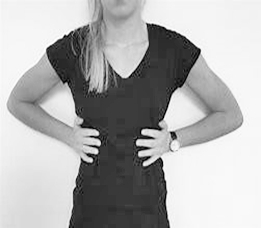 (III) Lateral Costal Breathing Exercise: Sit on chair or lay in bed. Place your both hand on sides of chest. Inhale deeply through your nose and hold for 4 to 5 secs. Exhale slowly from your mouth.
(III) Lateral Costal Breathing Exercise: Sit on chair or lay in bed. Place your both hand on sides of chest. Inhale deeply through your nose and hold for 4 to 5 secs. Exhale slowly from your mouth.
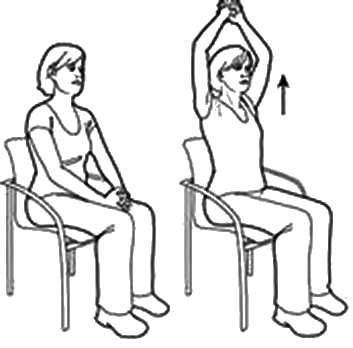
(IV) Deep Breathing With Synchronised Arm Movement: Sit on chair or lay in bed. Clasp your hands together. Take a deep breath through your nose and while raising your hands upward. Hold for 4 to 5 secs. Now exhale from your mouth slowly while bringing down your hands.
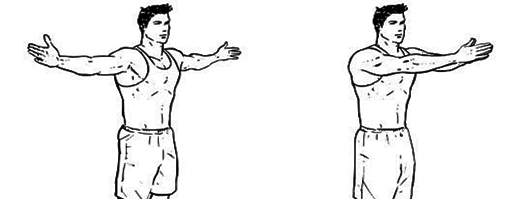 (V) Deep Breathing With Arm Movement: Sit on chair or stand. Stretch your arms in front of your and clasp them together. Inhale deeply through the nose while moving your hands apart and outwards from each other. Hold for 4 to 5 secs. Now slowly exhale from your mouth while bringing hands back to each other.
(V) Deep Breathing With Arm Movement: Sit on chair or stand. Stretch your arms in front of your and clasp them together. Inhale deeply through the nose while moving your hands apart and outwards from each other. Hold for 4 to 5 secs. Now slowly exhale from your mouth while bringing hands back to each other.
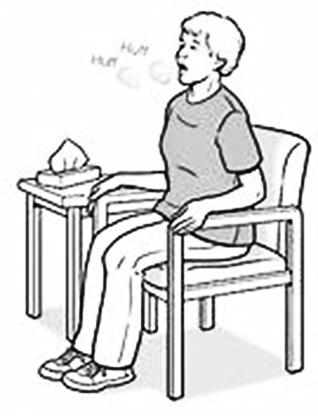
(VI) Single Breath Count Exercise: Sit on chair or lay in bed. Take a deep breath through your nose and mentally count the length of your breath with numbers like 1-2-3-4…. Another variant is the Forceful Expiration Breathing Exercise: Sit on a chair. Hold a piece of paper in front of you and try to blow the paper as far as you can. Alternately, you could consider blowing air into balloons.
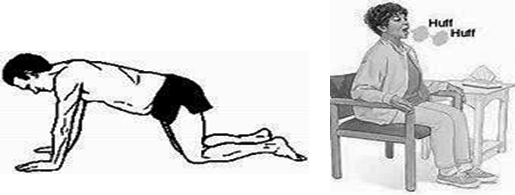 (VII) Huffing / Coughing: Sit on chair or in prone kneeling position. Inhale deeply through your nose. Now exhale sudden and quick breaths out from your mouth making sounds like hah-hah-hah and kha-kha-kha.
(VII) Huffing / Coughing: Sit on chair or in prone kneeling position. Inhale deeply through your nose. Now exhale sudden and quick breaths out from your mouth making sounds like hah-hah-hah and kha-kha-kha.
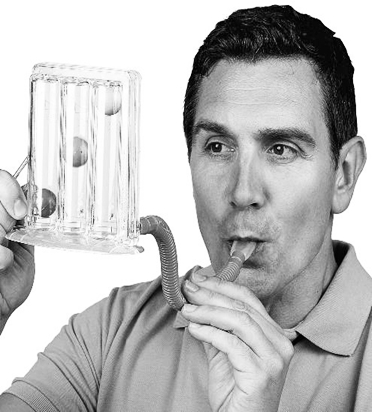 (VIII) Using Respirometer/Spirometer: Sit on chair or lay in bed. Place the mouthpiece of respirometer in your mouth and inhale a deep breath though the mouth. Hold for 4 to 5 secs.
(VIII) Using Respirometer/Spirometer: Sit on chair or lay in bed. Place the mouthpiece of respirometer in your mouth and inhale a deep breath though the mouth. Hold for 4 to 5 secs.
(IX) Steam Inhalations: Please do not add any oil or liniment to the water, it may adversely affect the lungs.
 (X) Breathing Deeply In Half-Lying Or Prone Position: During breathing difficulty, get into these positions, preferably prone position (face-down on bed). Inhale deeply through your nose and exhale slowly through your mouth. Try to mentally count the length of your breath with numbers like 1-2-3-4….
(X) Breathing Deeply In Half-Lying Or Prone Position: During breathing difficulty, get into these positions, preferably prone position (face-down on bed). Inhale deeply through your nose and exhale slowly through your mouth. Try to mentally count the length of your breath with numbers like 1-2-3-4….
- The Healing Power Of ‘Shinrin-Yoku’ (Forest Bathing) - 28 December2024
- The Incomparable Health Benefits Of Plant-Based Diet - 30 November2024
- The Role Of Physiotherapy In Mental Health: A Holistic Approach - 28 September2024

Great this was